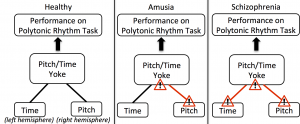 Basic Research Questions
Basic Research Questions1. Do schizophrenia patients’ rhythmic performances vary in the presence of tonal changes within rhythmic sequences?
2. Would such rhythmic performance variations themselves vary by the subjects’ pitch perception acuity?
3. Does rhythmic performance contribute to schizophrenia dysprosodia?
Perceiving social intent via vocal intonation (prosody) is profoundly impaired in schizophrenia. Recent studies demonstrate that schizophrenia dysprosodia arises in part from impaired pitch perception that upward generalizes into more complex prosodic processing impairment. Individuals with amusia (tone-deafness) are profoundly insensitive to pitch change. Like schizophrenia, amusia individuals also have prosody deficits. Amusia sensitivity to aperiodicity (rhythm) in tonal sequences is significantly reduced when these sequences contain tone-pitch changes, but otherwise, these individuals perceive rhythm normally in monotonic sequences. Amusia researchers have therefore suggested that perceptual impairment originates at a secondary processing stage where pitch and time aspects of audio-speech signals are yoked. Here, we investigate the pitch-time yoke in schizophrenia in comparison to the hypothesized amusia model.
Clinical Application
•This study is a first step toward the development of a paradigm suitable for studying conversations in a cognitively impaired population and will establish a benchmark for behavioral dependent variables that can be used reliably to measure the establishment of common conceptual ground and turn-taking dynamics.
•Modeling conversation in clinical populations provides key insights to the nature of the difficulties in conversing experienced by patients, as well as to ways in which such deficits can be remediated.
Behavioral Tasks
These tasks allow us to examine auditory perception, specifically pitch and rhythm, and how they relate to prosodic perception.
Rhythm
Tone Matching
Prosody
Distorted Tunes
Comments are closed.